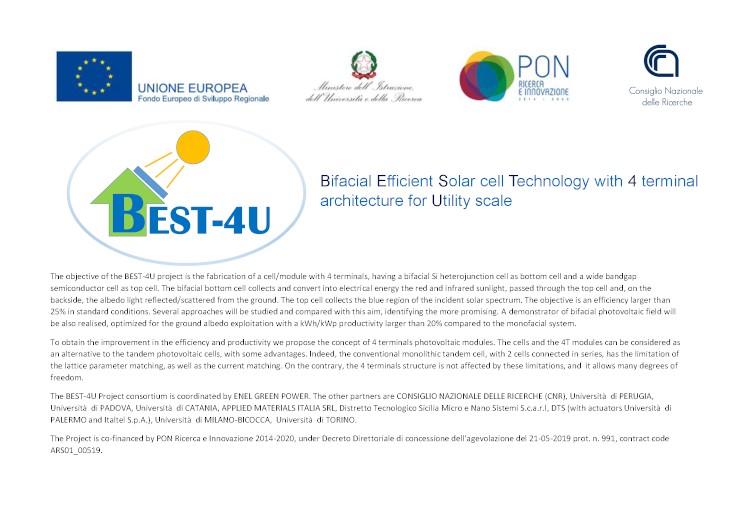This website uses cookies so that we can provide you with the best user experience possible. Cookie information is stored in your browser and performs functions such as recognising you when you return to our website and helping our team to understand which sections of the website you find most interesting and useful. More information in our Privacy Policy
BEST-4U
Bifacial Efficient Solar cell Technology with 4 terminal architecture for Utility scale
Principal investigator: Alessandra Sanson
Involved personnel: Nicola Sangiorgi, Alex Sangiorgi, Linda Bergamini
Starting date: 2020
Duration: 30 months
Total funding: 3.005.034 €
Action: PON Ricerca e Innovazione 2014-2020
Coordinator: Enel Green Power
Consortium: CNR, Università di Perugia, Università di Padova, Università di Catania, Applied Materials Italia s.r.l., Distretto Tecnologico Sicilia Micro e Nano Sistemi S.c.a.r.l (DTS), Università di PALERMO, Italtel S.p.A., Università di MILANO-BICOCCA, Università di TORINO.
Official web site: http://www.ponricerca.gov.it/
The project objective is the industrial research, aimed to find solutions to increase the efficiency of photovoltaic modules above 25%, and to improve the bifaciality, because this largely reduces the BOS and decreases the LCOE. In order to obtain the improvement in the efficiency and productivity we propose the concept of 4 terminals photovoltaic modules. The cells and the 4T modules can be considered as an alternative to the tandem photovoltaic cells, with some advantages. Indeed, the conventional monolithic tandem cell, with 2 cells connected in series, has the limitation of the lattice parameter matching, as well as the current matching. On the contrary, the 4 terminals structure is not affected by these limitations, and allows many degrees of freedom. The objective of the present proposal is therefore the fabrication of a cell/module with 4 terminals, having a bifacial Si heterojunction cell as bottom cell and a wide bandgap semiconductor cell as top cell. The bifacial bottom cell collects and convert into electrical energy the red and infrared sunlight, passed through the top cell and, on the backside, the albedo light reflected/scattered from the ground. The top cell collects the blue region of the incident solar spectrum. The objective is an efficiency larger than 25% in standard conditions. Several approaches will be studied and compared with this aim, identifying the more promising. A demonstrator of bifacial photovoltaic field will be also realised, optimized for the ground albedo exploitation with a kWh/kWp productivity larger than 20% compared to the monofacial system.
ISTEC will be mainly involved in the Implementation Objective (OR) 3 which plans to develop hybrid organic-inorganic solar cells as TOP cells of a 4-terminal configuration with silicon-based BOTTOM cells. Two technologies will be investigated: dye cells (DSSCs) and Perovskite solar cells (PSCs).

